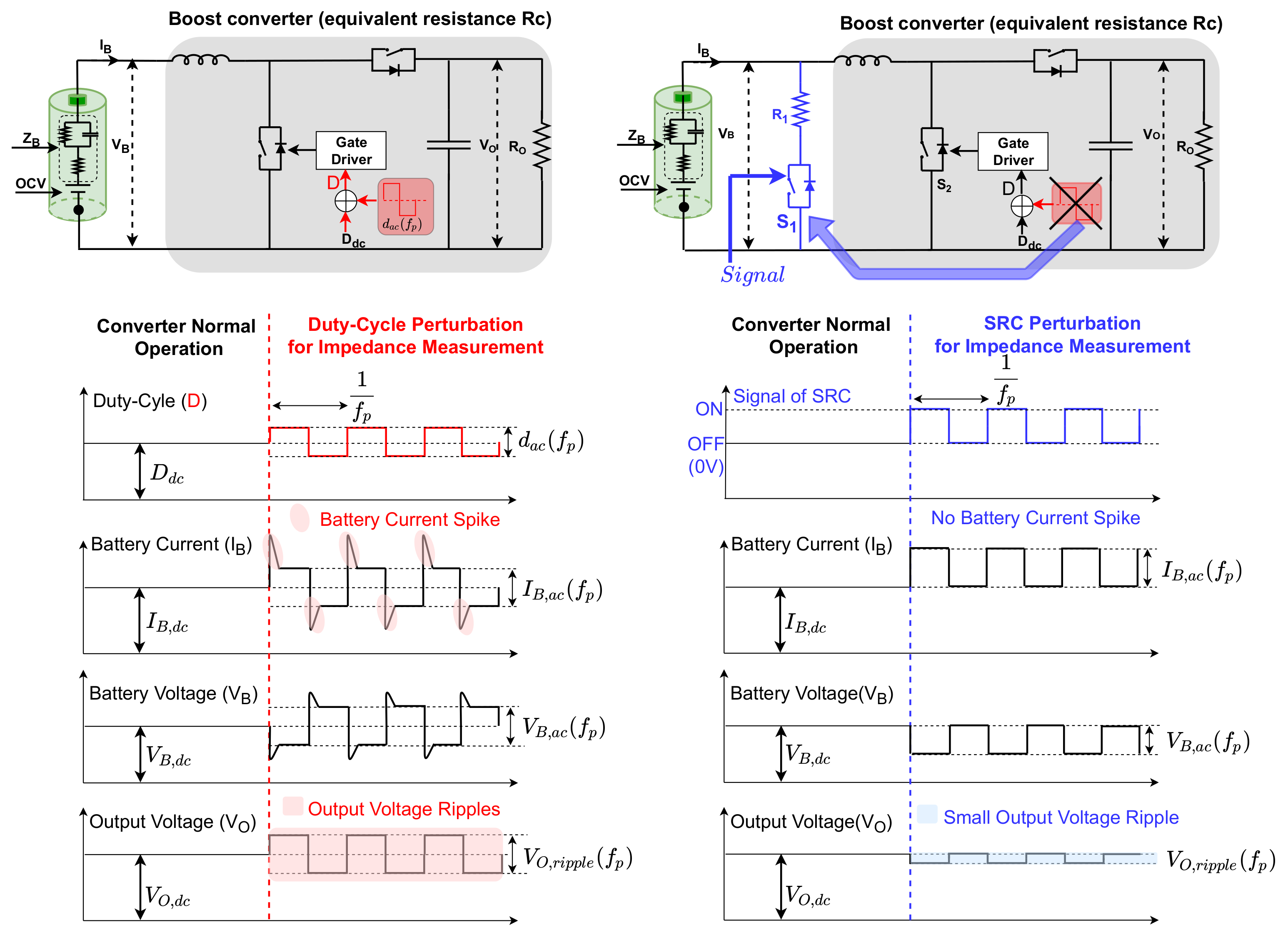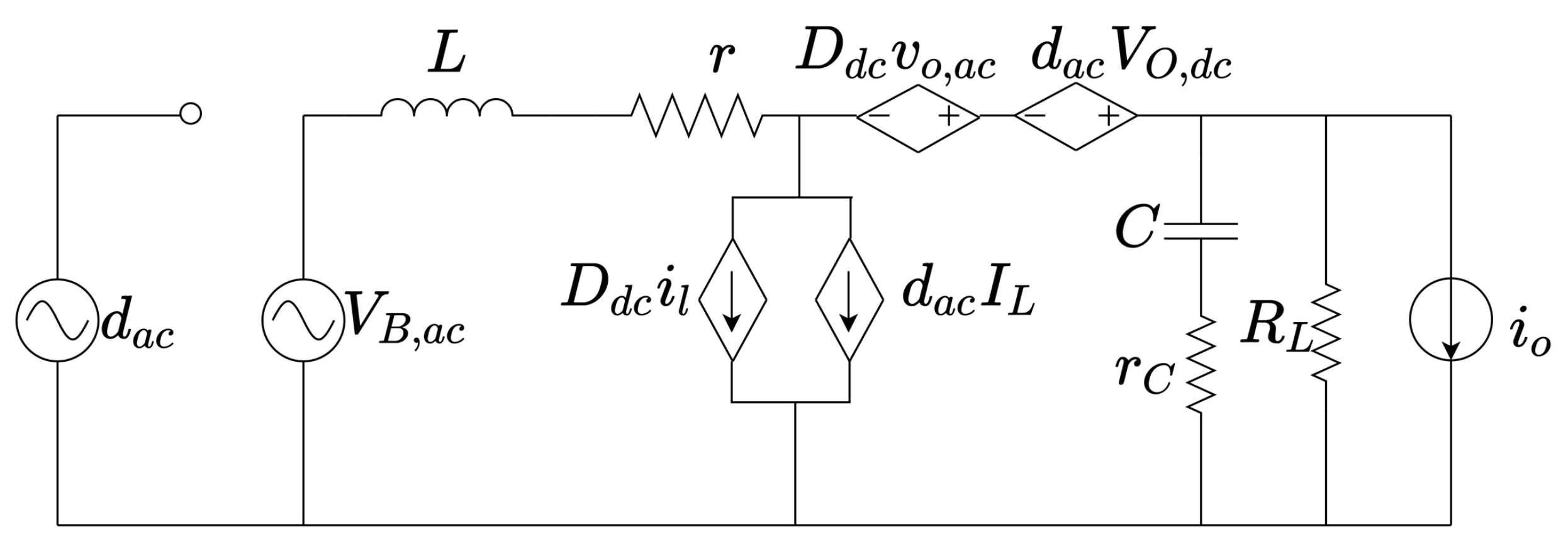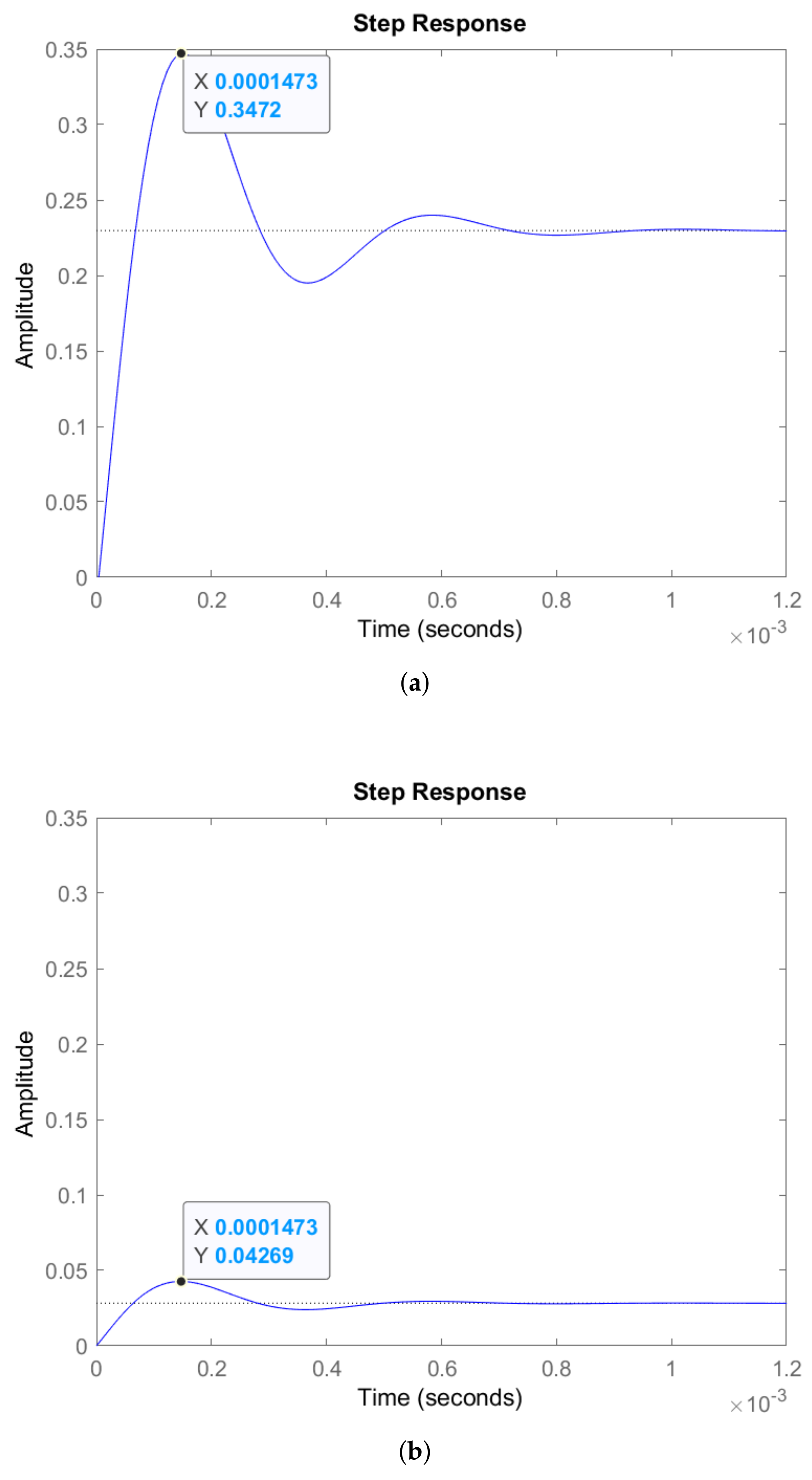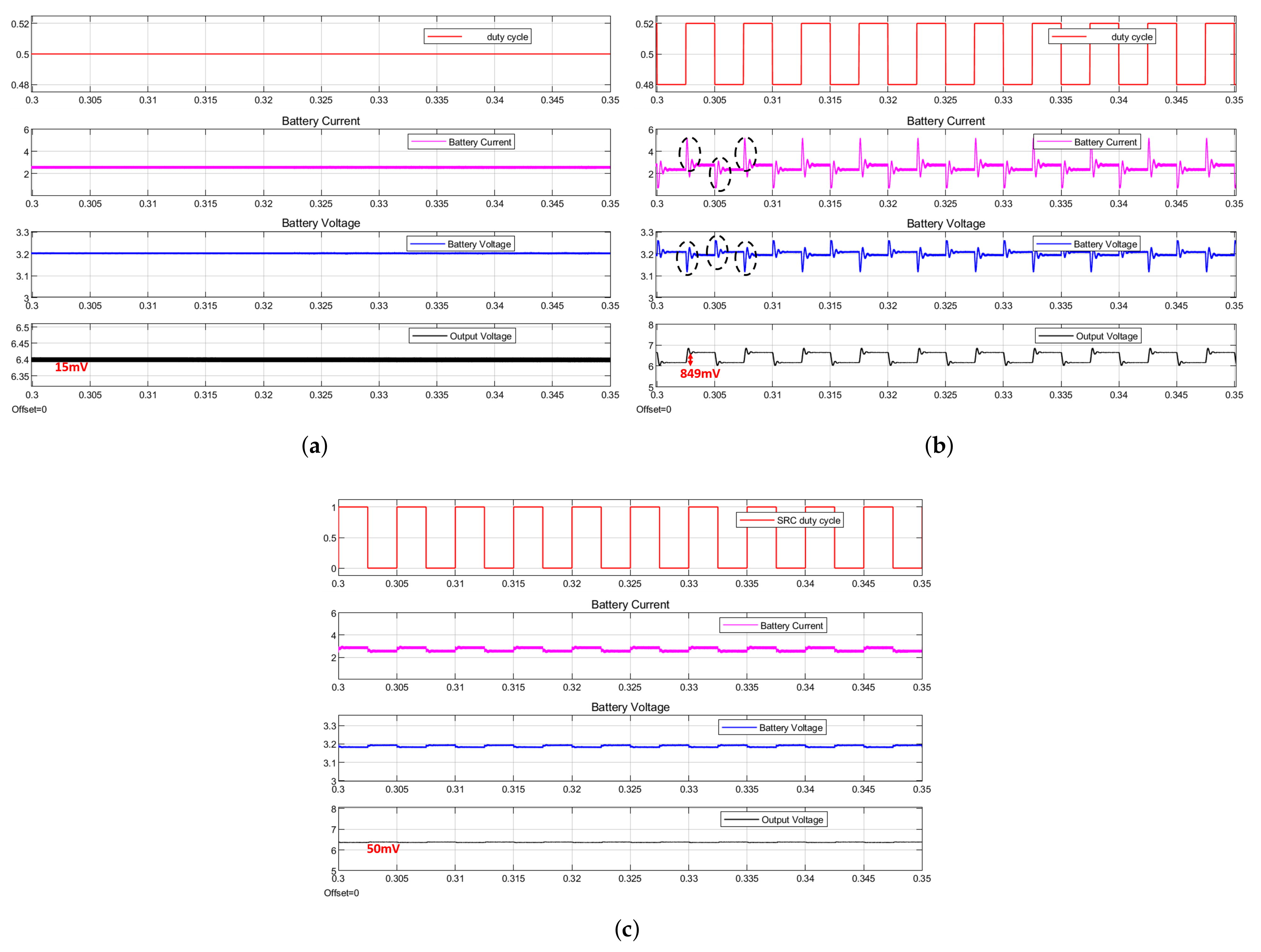Accurate Online Battery Impedance Measurement Method with Low Output Voltage Ripples on Power Converters
Abstract
1. Introduction
2. Background
2.1. EIS Measurement
2.2. Converter Normal Operation
2.3. Review of the Converter-Based Duty Cycle Perturbation Battery Impedance Measurement Method
3. Proposed Switched Resistor Circuit Perturbation Method for Output Voltage Ripple Reduction
3.1. Principle of the SRC Perturbation Method
3.2. SRC Parameter Selection
3.3. Theoretical Verification of Output Voltage Ripple Reduction in the Proposed SRC Perturbation Method
3.4. Simulation Verification of Output Voltage Ripple Reduction in the Proposed SRC Perturbation Method
3.5. Experimental Verification of Output Voltage Ripple Reduction in the Proposed SRC Method
4. Battery Impedance Measurement Validation
4.1. Battery Multi-Frequency Impedance Calculation Algorithm
4.2. Online Battery Impedance Test at 50% SOC, 1C Discharge Current Rate
4.3. Online Battery Impedance Tests at Various Battery SOC
4.4. Online Battery Impedance Tests at Various Discharge Current Rates
5. Conclusions
Author Contributions
Funding
Institutional Review Board Statement
Informed Consent Statement
Data Availability Statement
Conflicts of Interest
References
- Howey, D.A.; Mitcheson, P.D.; Yufit, V.; Offer, G.J.; Brandon, N.P. Online measurement of battery impedance using motor controller excitation. IEEE Trans. Veh. Technol. 2013, 63, 2557–2566. [Google Scholar] [CrossRef]
- Din, E.; Schaef, C.; Moffat, K.; Stauth, J.T. A scalable active battery management system with embedded real-time electrochemical impedance spectroscopy. IEEE Trans. Power Electron. 2016, 32, 5688–5698. [Google Scholar] [CrossRef]
- Dai, H.; Jiang, B.; Wei, X. Impedance characterization and modeling of lithium-ion batteries considering the internal temperature gradient. Energies 2018, 11, 220. [Google Scholar] [CrossRef]
- Meng, J.; Luo, G.; Ricco, M.; Swierczynski, M.; Stroe, D.I.; Teodorescu, R. Overview of lithium-ion battery modeling methods for state-of-charge estimation in electrical vehicles. Appl. Sci. 2018, 8, 659. [Google Scholar] [CrossRef]
- Qahouq, J.A.A.; Xia, Z. Single-perturbation-cycle online battery impedance spectrum measurement method with closed-loop control of power converter. IEEE Trans. Ind. Electron. 2017, 64, 7019–7029. [Google Scholar] [CrossRef]
- Kwiecien, M.; Badeda, J.; Huck, M.; Komut, K.; Duman, D.; Sauer, D.U. Determination of soh of lead-acid batteries by electrochemical impedance spectroscopy. Appl. Sci. 2018, 8, 873. [Google Scholar] [CrossRef]
- Meng, J.; Ricco, M.; Luo, G.; Swierczynski, M.; Stroe, D.I.; Stroe, A.I.; Teodorescu, R. An overview and comparison of online implementable SOC estimation methods for lithium-ion battery. IEEE Trans. Ind. Appl. 2017, 54, 1583–1591. [Google Scholar] [CrossRef]
- Huang, W.; Qahouq, J.A.A. An online battery impedance measurement method using dc–dc power converter control. IEEE Trans. Ind. Electron. 2014, 61, 5987–5995. [Google Scholar] [CrossRef]
- Gücin, T.N.; Ovacik, L. Online Impedance Measurement of Batteries Using the Cross-Correlation Technique. IEEE Trans. Power Electron. 2019, 35, 4365–4375. [Google Scholar] [CrossRef]
- Kuipers, M.; Schröer, P.; Nemeth, T.; Zappen, H.; Blömeke, A.; Sauer, D.U. An Algorithm for an Online Electrochemical Impedance Spectroscopy and Battery Parameter Estimation: Development, Verification and Validation. J. Energy Storage 2020, 30, 101517. [Google Scholar] [CrossRef]
- Moral, C.G.; Fernandez, D.; Guerrero, J.M.; Reigosa, D.; Riva, C.; Briz, F. Thermal monitoring of LiFePO4 batteries using switching harmonics. IEEE Trans. Ind. Appl. 2020, 56, 4134–4145. [Google Scholar]
- Xia, Z.; Qahouq, J.A.A. Method for online battery AC impedance spectrum measurement using dc-dc power converter duty cycle control. In Proceedings of the 2017 IEEE Applied Power Electronics Conference and Exposition (APEC), Tampa, FL, USA, 26–30 March 2017; pp. 1999–2003. [Google Scholar]
- Uddin, K.; Moore, A.D.; Barai, A.; Marco, J. The effects of high frequency current ripple on electric vehicle battery performance. Appl. Energy 2016, 178, 142–154. [Google Scholar] [CrossRef]
- Hwu, K.; Yau, Y. A KY boost converter. IEEE Trans. Power Electron. 2010, 25, 2699–2703. [Google Scholar] [CrossRef]
- Zhao, L.; Qian, J. DC-DC power conversions and system design considerations for battery operated system. Texas Instrum. 2006, 6, 1–18. [Google Scholar]
- Cao, Y.; Yang, H.; Gao, T.; Shao, S.; Zhang, B. Switched-mode Control of Battery Backup Unit in Data Center for Online Impedance Detection. In Proceedings of the 2020 IEEE Applied Power Electronics Conference and Exposition (APEC), New Orleans, LA, USA, 15–19 March 2020; pp. 3332–3336. [Google Scholar]
- Islam, S.R.; Park, S.Y. Precise On-line Electrochemical Impedance Spectroscopy Strategies for Li-Ion Batteries. IEEE Trans. Ind. Appl. 2019, 56, 1661–1669. [Google Scholar] [CrossRef]
- Kopczyński, A.; Liu, Z.; Krawczyk, P. Parametric analysis of Li-ion battery based on laboratory tests. In Proceedings of the E3S Web of Conferences, EDP Sciences, Polanica-Zdroj, Poland, 16–18 April 2018; Volume 44, p. 00074. [Google Scholar]
- Czarkowski, D.; Kazimierczuk, M.K. Energy-conservation approach to modeling PWM DC-DC converters. IEEE Trans. Aerosp. Electron. Syst. 1993, 29, 1059–1063. [Google Scholar] [CrossRef]
- Ayachit, A.; Kazimierczuk, M.K. Averaged small-signal model of PWM DC-DC converters in CCM including switching power loss. IEEE Trans. Circuits Syst. II Express Briefs 2018, 66, 262–266. [Google Scholar] [CrossRef]
- Sihvo, J.; Stroe, D.I.; Messo, T.; Roinila, T. Fast Approach for Battery Impedance Identification Using Pseudo-Random Sequence Signals. IEEE Trans. Power Electron. 2019, 35, 2548–2557. [Google Scholar] [CrossRef]
- Golestan, S.; Ramezani, M.; Guerrero, J.M.; Freijedo, F.D.; Monfared, M. Moving average filter based phase-locked loops: Performance analysis and design guidelines. IEEE Trans. Power Electron. 2013, 29, 2750–2763. [Google Scholar] [CrossRef]
- Ratnakumar, B.; Smart, M.; Whitcanack, L.; Ewell, R. The impedance characteristics of Mars Exploration Rover Li-ion batteries. J. Power Sources 2006, 159, 1428–1439. [Google Scholar] [CrossRef]









| Design Parameter | Value |
|---|---|
| Battery | 3.5 V |
| 0.0322 | |
| 0.026 | |
| 375.94 F | |
| Duty cycle D | 0.5 |
| Inductor L | 4.7 H |
| Capacitor C | 220 F |
| Inductor ESR | 0.0028 |
| Capacitor ESR | 0.311 |
| MOSFET ON resistance | 0.077 |
| Diode forward resistance | 0.072 |
| Operation frequency | 150 kHz |
| Perturbation frequency | 200 Hz |
| Output resistor | 10 |
| Perturbed Current (A) | Perturbed Voltage (V) | Output Ripples (V) | THD | |||
|---|---|---|---|---|---|---|
| No Perturbation | 0 | 0 | 0 | 0.015 | 0.1% | |
| Duty Cycle Method | 0.01 | 0.1095 | 0.00355 | 0.471 | 2.77% | |
| 0.015 | 0.1648 | 0.00533 | 0.681 | 4.14% | ||
| 0.02 | 0.2201 | 0.00712 | 0.849 | 5.48% | ||
| Proposed SRC method | 0 | 0.2786 | 0.009 | 0.050 | 0.25% |
| Design Parameter | Value |
|---|---|
| Battery | INR18650 |
| Duty cycle D | 0.5 |
| SRC resistor | 10, 3 W |
| SRC switching duty cycle | 50% |
| Inductor L | 4.7 H |
| Capacitor C | 220 F |
| Operation frequency | 150 kHz |
| Electronic load | BK8500 |
| Controller | Arduino |
| Data logger | NI 6009 |
Publisher’s Note: MDPI stays neutral with regard to jurisdictional claims in published maps and institutional affiliations. |
© 2021 by the authors. Licensee MDPI, Basel, Switzerland. This article is an open access article distributed under the terms and conditions of the Creative Commons Attribution (CC BY) license (http://creativecommons.org/licenses/by/4.0/).
Share and Cite
Yao, Q.; Lu, D.-D.-C.; Lei, G. Accurate Online Battery Impedance Measurement Method with Low Output Voltage Ripples on Power Converters. Energies 2021, 14, 1064. https://doi.org/10.3390/en14041064
Yao Q, Lu D-D-C, Lei G. Accurate Online Battery Impedance Measurement Method with Low Output Voltage Ripples on Power Converters. Energies. 2021; 14(4):1064. https://doi.org/10.3390/en14041064
Chicago/Turabian StyleYao, Qi, Dylan-Dah-Chuan Lu, and Gang Lei. 2021. "Accurate Online Battery Impedance Measurement Method with Low Output Voltage Ripples on Power Converters" Energies 14, no. 4: 1064. https://doi.org/10.3390/en14041064
APA StyleYao, Q., Lu, D.-D.-C., & Lei, G. (2021). Accurate Online Battery Impedance Measurement Method with Low Output Voltage Ripples on Power Converters. Energies, 14(4), 1064. https://doi.org/10.3390/en14041064







